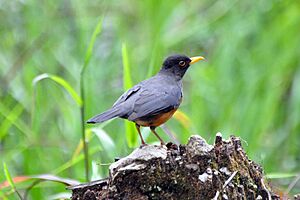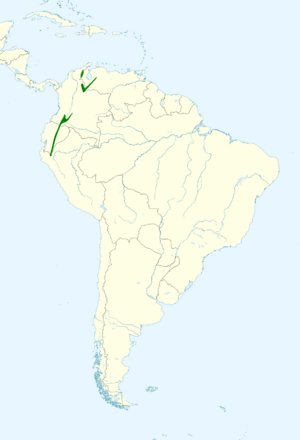Chestnut-bellied thrush facts for kids
Quick facts for kids Chestnut-bellied thrush |
|
|---|---|
 |
|
| Chestnut-bellied thrush in Guacamayos Ridge, Ecuador | |
| Conservation status | |
| Scientific classification | |
| Genus: |
Turdus
|
| Species: |
fulviventris
|
 |
|
The chestnut-bellied thrush (Turdus fulviventris) is a cool bird found in South America. It lives in countries like Colombia, Ecuador, Peru, and Venezuela. This bird loves to live in moist mountain forests, even if some parts of the forest are not as wild as they used to be. It belongs to the thrush family, which is called Turdidae.
Contents
What Does It Look Like?
This thrush is about 25 cm (10 in) long, which is about the length of a ruler. The male bird has a black head and a black throat with some white lines. Its back is dark grey, and its wings and tail are a bit darker.
Colors and Features
The top part of its chest is light grey. But the lower part of its chest and its belly are a pretty reddish-brown color, which is called rufous. Its beak is bright yellow, and it has a thin orange ring around its eyes. Its legs are a dull yellow.
Male vs. Female
Female chestnut-bellied thrushes look similar to the males. However, their colors are usually not as bright. This bird is special because it's the only thrush in its group (the Turdus genus) with a reddish-brown belly that lives in the northern Andes mountains.
Its Song
This bird doesn't sing very often. When it does, its song is made up of different short sounds. It also includes some buzzing noises and quick trills.
Where Does It Live?
The chestnut-bellied thrush lives in the northwestern part of South America. You can find it in western Venezuela, western Colombia, Ecuador, northern Peru, and northwestern Bolivia.
Its Home
This bird's home is in woodlands. It also lives in the tops of trees (the canopy) and at the edges of mountain forests. It prefers to live at high places, usually between 1,400 and 2,600 m (4,600 and 8,500 ft) above sea level.
How Does It Live?
This thrush often flies around by itself. Sometimes, you might see it in pairs. However, it usually doesn't join big groups of different types of birds.
Foraging for Food
Male thrushes might sing from high up in the trees. Both male and female thrushes often look for food among the small branches and twigs. They sometimes fly down to the ground, especially near roads and paths. There, they flip over fallen leaves to find small creatures like invertebrates to eat. They might stay in one spot for a while as they search for food.
Is It Safe?
The chestnut-bellied thrush is not a very common bird. Experts believe that the number of these birds is slowly going down. This is because the forests where they live are changing or being cut down.
Conservation Status
Even though its numbers are declining, this bird lives across a very large area. This means there are still many of them in total. Because of its wide range and large population, the International Union for Conservation of Nature (IUCN) says that the chestnut-bellied thrush is a "least concern" species. This means it's not currently in danger of disappearing.


